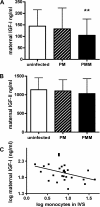Placental malaria-associated inflammation disturbs the insulin-like growth factor axis of fetal growth regulation
- PMID: 21216864
- PMCID: PMC3071224
- DOI: 10.1093/infdis/jiq080
Placental malaria-associated inflammation disturbs the insulin-like growth factor axis of fetal growth regulation
Abstract
Background: The pathogenetic mechanisms of fetal growth restriction associated with placental malaria are largely unknown. We sought to determine whether placental malaria and related inflammation were associated with disturbances in the insulin-like growth factor (IGF) axis, a major regulator of fetal growth.
Method: We measured IGF-1 and IGF-2 concentrations in plasma from 88 mother-neonate pairs at delivery and IGF binding proteins 1 and 3 (IGFBP-1 and IGFBP-3, respectively) in cord plasma from a cohort of Papua New Guinean women with and without placental malaria. Messenger RNA levels of IGF-1, IGF-2, and the IGF receptors were measured in matched placental biopsy specimens.
Results: Compared with those for uninfected pregnancies, IGF-1 levels were reduced by 28% in plasma samples from women with placental Plasmodium falciparum infection and associated inflammation (P = .007) and by 25% in their neonates (P = .002). Levels of fetal IGFBP-1 were elevated in placental malaria with and without inflammation (P = .08 and P = .006, respectively) compared with uninfected controls. IGF-2 and IGFBP-3 plasma concentrations and placental IGF ligand and receptor messenger RNA transcript levels were similar across groups.
Conclusion: Placental malaria-associated inflammation disturbs maternal and fetal levels of IGFs, which regulate fetal growth. This may be one mechanism by which placental malaria leads to fetal growth restriction.
Figures



References
-
- Desai M, ter Kuile FO, Nosten F, et al. Epidemiology and burden of malaria in pregnancy. Lancet Infect Dis. 2007;7:93–104. - PubMed
-
- Rogerson SJ, Pollina E, Getachew A, Tadesse E, Lema VM, Molyneux ME. Placental monocyte infiltrates in response to Plasmodium falciparum malaria infection and their association with adverse pregnancy outcomes. Am J Trop Med Hyg. 2003;68:115–9. - PubMed
-
- Ordi J, Ismail MR, Ventura PJ, et al. Massive chronic intervillositis of the placenta associated with malaria infection. Am J Surg Pathol. 1998;22:1006–11. - PubMed
-
- Fried M, Muga RO, Misore AO, Duffy PE. Malaria elicits type-1 cytokines in the human placenta: IFN gamma and TNF alpha associated with pregnancy outcomes. J Immunol. 1998;160:2523–30. - PubMed
Publication types
MeSH terms
Substances
LinkOut - more resources
Full Text Sources
Medical
Miscellaneous

